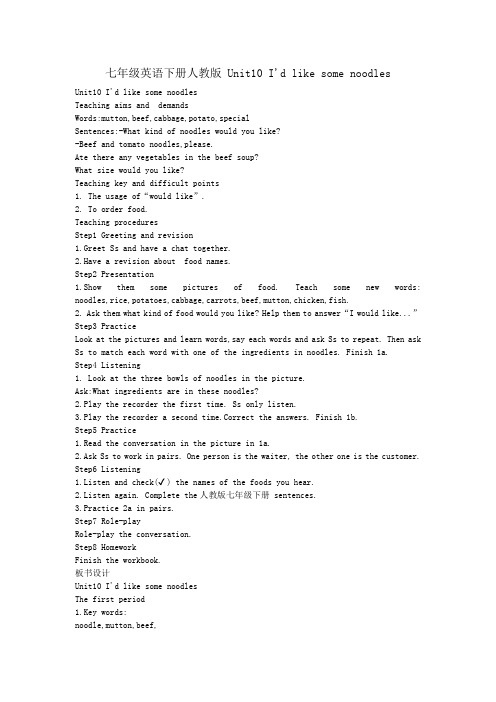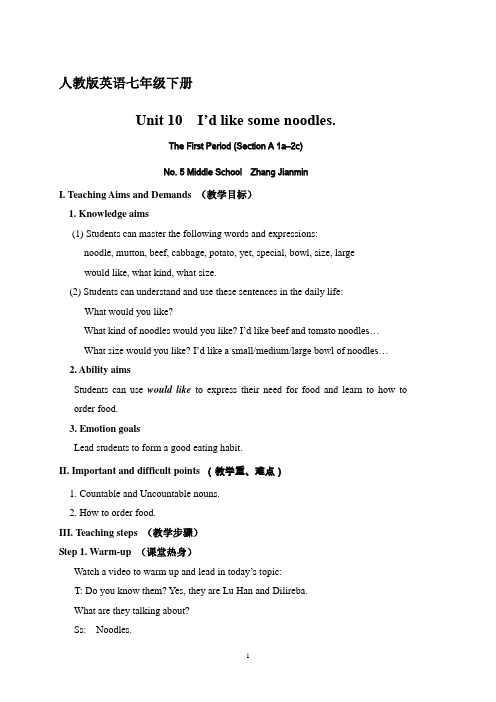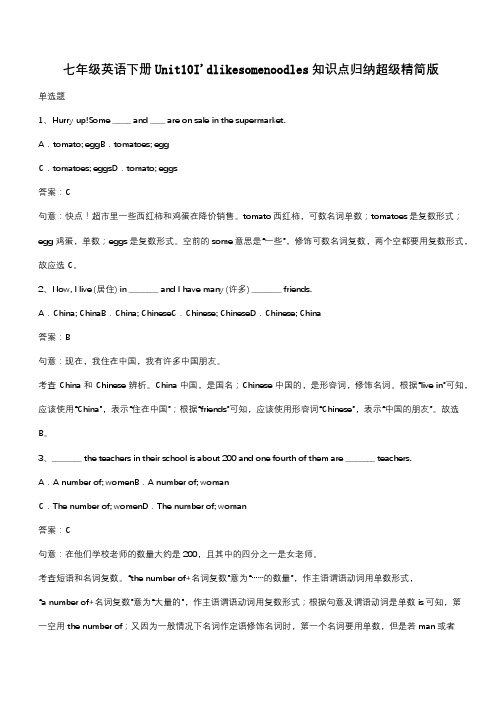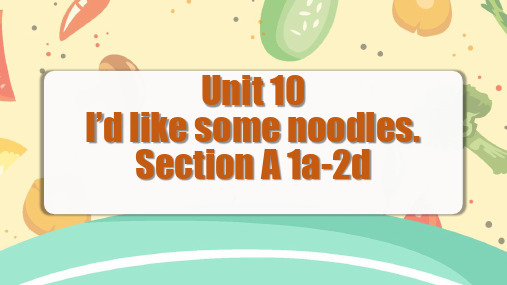七年级英语下册Unit10I’dlikesomenoodlesRevision教案1新版人教新目标版
七年级英语下册《Unit10Ix27dlikesomenoodles》教学(新版)人教新目标版

教课资料范本七年级英语下册《 Unit 10 I'd like some noodles 》教课(新版)人教新目标版编辑: __________________时间: __________________Unit 10 I’d like somenoodles.Learning Objectives一、 Topic s(话题) :Food二、 Functions ( 功能)Order food三、 Structures (构造)1.would like2.What questions3.some/any四、 Target Language (目口号言)What kind of noodles would you like?I ’d like beef and tomato noodles, please.What size would you like?I ’d like a small/medium/large bowl of noodles.Would you like any drinks?One large green tea.五、 Vocabulary(词汇)beef, noodles, cabbage, potato, meat, fish, dumpling, soup,pancake, cake, bowl, size, order, large, popular, specialwould like, take one’s order, two bowls of, blow out, make a wish, get popular, cut up, bring good luck to六、 Skills (技术)Listening for key informationScanning in reading七、 Recycling(复习稳固)Numbers 1-9Is there?Are there?They are hers.八、教材剖析本单元的话题是对于食品。
七年级下册Unit10I'dlikesomenoodlesUnit10I写作课教案

Unit 10 I’d like some noodlesWriting (Section B 3a-3c)Date: . 2023Teacher: Tang WanjuType of lesson: writingⅠ.教材分析The analysis of the teaching materials3a的练习要求学生联系上下文,将零碎的句子形成一个完整的对话用方框中的单词填空,这要求学生能找到每个句中的关键词,再结合语境用正确的单词填空。
3b是让学生整理所学的食物名词及价格。
3c首先让学生进行对3a的句型总结,让学生了解句型结构,为之后的写作做好铺垫。
整个课程是通过过程性写作板块的训练,达到能够运用重点句型完成写作的任务。
Ⅱ.学情分析The analysis of the students学生学英语四个环节:听-说-读-写,写是最难的一个环节,四个环节环环相扣,只有做好了听,说,读的基础,才能进行写这一环节。
所以在写作前先做好词,句的练习,让学生在这个过程中有循可依,也做到了学以致用。
Ⅲ. 教学目标Teaching aims•语言目标Language goals掌握以下句型:--We have some ………--A medium bowl of …..is ….yuan/dollars.--T here are some… i n/at our restaurant.--Would you like sth./to do sth.•能力目标Ability goalsSs can use the key sentences to fill in the blanks.Ss can write an ad with the sentence structures .•情感目标Emotion and valuesⅣ. 教学重难点Teaching key and difficult point1.教学重点:1) 通过进行听、说的训练,来提高学生们综合运用所学知识的能力。
七年级英语下册基础训练Unit10I’dlikesomenoodles讲义新版人教新目标版

Unit10 I’dlikesomenoodles.(讲义)Part 1 Words and Expressionsnoodle/'nuːdl/ n. 面条mutton /'mʌtn/ n. 羊肉beef/biːf/ n.牛肉cabbage/'kæbɪdʒ/ n. 卷心菜;洋白菜potato/pə'teɪtəʊ/ n. 土豆;马铃薯 special/'speʃəl/ n. 特色菜;特价品adj. 特别的;特殊的would/wʊd/ modal v. (表示意愿)愿意would like (表示意愿)愿意;喜欢yet/jet/ adv.(常用于否定句或疑问句)还;仍然large/lɑː(r)dʒ/ adj. 大号的;大的order/'ɔː(r)də(r)/n.&v. 点菜;命令take one’s order点菜size/saɪz/ n. 大小;尺码bowl/bəʊl/ n. 碗one (large) bowlof 一(大)碗……tofu/'təʊfuː/ n. 豆腐meat /miːt/ n. (可食用的)肉dumpling /'dʌmplɪŋ/n. 饺子porridge/'pɒrɪdʒ/n. 粥;面糊onion/'ʌnjən/ n. 洋葱fish/fɪʃ/ n. 鱼;鱼肉pancake/'pænkeɪk/ n. 烙饼;薄饼world/wɜː(r)ld/ n.世界aroundtheworld 世界各地answer/'ɑːnsə/ n. 答案v. 回答different/'dɪfərənt/ adj. 不同的cake/keɪk/ n. 蛋糕candle/'kændl/n. 蜡烛age/eɪdʒ/ n. 年龄makeawish 许愿blow/bləʊ/ v. 吹blowout 吹灭if/ɪf/ conj.如果will/wɪl/ v. 将要;会the UK /,ju: 'kei/(=the United Kingdom /ju'naɪtɪ d 'kɪŋdəm/)n. 英国candy/'kændi/n. 糖果lucky/'lʌki/ adj. 幸运的popular/'pɒpjʊlə/ adj.受欢迎的;普遍的getpopular 受欢迎;流行cutup 切碎idea/aɪ'dɪə/ n. 想法;主意bringgoodluckto…给……带来好运specialn. 特色菜;特价品We have some great specials today.adj. 特殊的;特别的The teacher always makes every child feel special.I would like you to try this kind of food. It is veryspecial. Bob is a special friend of mine.wouldlikeI want a large bowl of noodles.I would like a large bowl of noodles.I want to order a cup of coffee.I would like to order a cup of coffee.would like 意为“想要;愿意”,比want 语气更委婉。
七年级英语下册Unit10I’dlikesomenoodles重点解析素材人教新目标版(new)

Unit 10 I'd like some noodles 重点解析Section A1. What would you like?你想要点什么?原句是what引导的特殊疑问句,用来询问对方想要什么。
回答一般用“I would like (可以缩写成I’d like)。
."。
would like意为“想要”,相当于want,其中would没有人称和数的变化。
would like常用于以下结构:★would like +名词/代词,表示“想要某物”。
如:I'd like an apple。
我想要一个苹果。
★would like to do sth.表示“想要做某事",是委婉客气的说法。
如:We’d like to go to the movies this evening。
今晚我们想去看电影.★would like sb. to do sth. 表示“想要某人做某事”.如:He would like me to help him with his English. 他想让我帮助他学英语。
I’d like。
.。
变一般疑问句时把would提前,即Would you like。
..? 意为“你想要……吗?”,也是征求别人意见的常用句型,语气较委婉。
Would you like to do .。
.?意为“你想做……吗?”回答一般为Yes, I’d like to。
/ I’d like to, but I.。
. 如:— Would you like some beef?你想要一些牛肉吗?— Yes, please./ No, thanks. 好的。
/不,谢谢。
— Would you like to go shopping with me?你愿意和我一起去购物吗?— Yes, I'd like to。
/ I’d like to, but I have to visit my friend. 是的,我愿意。
七年级英语下册人教版 Unit10 I'd like som

七年级英语下册人教版 Unit10 I'd like some noodlesUnit10 I'd like some noodlesTeaching aims and demandsWords:mutton,beef,cabbage,potato,specialSentences:-What kind of noodles would you like?-Beef and tomato noodles,please.Ate there any vegetables in the beef soup?What size would you like?Teaching key and difficult points1. The usage of“would like”.2. To order food.Teaching proceduresStep1 Greeting and revision1.Greet Ss and have a chat together.2.Have a revision about food names.Step2 Presentation1.Show them some pictures of food. Teach some new words: noodles,rice,potatoes,cabbage,carrots,beef,mutton,chicken,fish.2. Ask them what kind of food would you like? Help them to answer“I would like...”Step3 PracticeLook at the pictures and learn words,say each words and ask Ss to repeat. Then ask Ss to match each word with one of the ingredients in noodles. Finish 1a.Step4 Listening1. Look at the three bowls of noodles in the picture.Ask:What ingredients are in these noodles?2.Play the recorder the first time. Ss only listen.3.Play the recorder a second time.Correct the answers. Finish 1b.Step5 Practice1.Read the conversation in the picture in 1a.2.Ask Ss to work in pairs. One person is the waiter, the other one is the customer. Step6 Listening1.Listen and check(✔) the names of the foods you hear.2.Listen again. Complete the人教版七年级下册 sentences.3.Practice 2a in pairs.Step7 Role-playRole-play the conversation.Step8 HomeworkFinish the workbook.板书设计Unit10 I'd like some noodlesThe first period1.Key words:noodle,mutton,beef,cabbage,potato,special,would,would like,yet,order,bowl,size, tofu,large2.Sentences:-What would you like?-I'm not sure yet.-What kind of noodles would you like?-I'd like beef noodles,please.May I take your order?Can we have two bowls of beef soup then?-What size would you like?-Medium,please.。
2025版七年级英语下册Unit10I’dlikesomenoodles教案新版人教新目标版

①—What would you like?
—I’m not sure yet. Are there any vegetables in the beef noodles?
②May I take your order?
③—Can we have two bowls of beef soup then?
—Sure. What size would you like?
—Medium, please.
实力
目标
能了解以下语法: 情态动词would的用法; 能驾驭订餐或叫外卖等的用语。
情感
目标
体会学习英语的乐趣, 做到“在用中学”“在学中用”。养成一个良好的饮食习惯。
教学
重点
1. 学习驾驭本课时的重点词组及表达方式。
1. Present the conversation in 1b on the big screen and ask Ss to practice it.
2. Make their own conversations using the noodles in the picture.
3. Let some pairs act out their conversations.
1. I’d like some noodles. (改为否定句)
I_________________________noodles.
2. Can I help you? (同义句)
_______can I_________________you?
3. I’d like some orange juice. (改为一般疑问句)
2. Show the conversations of2aon the big screen to the Ss.
人教版七年级英语下册Unit10I’dlikesomenoodles.(Review)教学设计

(三)学生小组讨论
在这个环节,我设计了以下活动:
1.小组讨论:我将学生们分成若干小组,让他们讨论以下问题:“What is your favorite food? Why do you like it?”学生们积极发言,分享了自己的喜好和原因。这个活动促进了学生之间的交流,提高了他们的合作能力。
2.语法应用:学生们需要运用一般现在时表达喜好,如“I like...”, “I don't like...”。部分学生可能对一般现在时的用法不够熟悉,因此在实际运用中可能会出现错误。如何让学生熟练掌握并运用一般现在时表达喜好将是本节课的另一个教学难点。
3.口语交流:在本节课中,学生们需要参与到关于食物和喜好的对话中。对于部分学生来说,口语表达仍存在一定的困难,如何在课堂活动中给予他们更多的机会练习口语,提高他们的口语表达能力将是本节课的教学难点之一。
1.作业与课堂内容相关:我布置的作业紧扣本节课的教学内容,旨在巩固学生们所学的知识。例如,我让他们绘制一幅关于自己最喜欢的食物的图画,并配以英语说明。这个作业让学生们在实践中运用所学知识,提高他们的实际运用能力。
2.作业具有多样性:我采用了多种形式的作业,如绘画、写作等,以满足不同学生的学习需求。这样既能激发学生的学习兴趣,又能让他们在不同的活动中提高自己的能力。
3.培养学生与人合作、交流的能力,提高他们的团队协作精神。
4.培养学生自主学习的能力,培养他们独立思考和解决问题的能力。
二、学情分析
在进入本单元的教学之前,我对学生的学习情况进行了一次全面的分析。根据我的观察和了解,学生们在之前的学习中已经掌握了基本的日常英语交流能力,能够运用简单的英语进行自我介绍、询问他人信息等。他们对英语学习的兴趣较为浓厚,且在学习过程中表现出较强的积极性。
人教版英语七年级下册Unit10I’dlikesomenoodlesⅡ课时优秀教学案例

(二)讲授新知
1.教授情态动词“would like”的用法,让学生理解并掌握其表达意思。
2.讲解本课核心句型,如:“I’d like some noodles, please.”“How about some dumplings?”等,并让学生进行实际操作练习。
在教学过程中,我以实际生活中的饮食场景为导入,激发学生对食物的兴趣。通过展示不同美食图片,引导学生运用“I’d like ...”句型表达自己的喜好。接着,设计小组活动,让学生在互动交流中实践所学内容,提高实际运用英语的能力。在课堂总结环节,强调健康饮食的重要性,引导学生养成良好的饮食习惯。
为了确保教学目标的有效达成,我采用了任务型教学法、情境教学法和交际法等多种教学手段。在教学过程中,注重发挥学生的主体作用,鼓励他们积极参与课堂活动,培养他们的合作精神和创新意识。同时,对学生的表现给予及时的反馈和评价,以激发他们的学习兴趣和自信心。
2.组织学生进行自我评价,培养他们的自我评估能力。
3.教师对学生的表现进行总结性评价,强调积极方面,提出改进建议。
四、教学内容与过程
(一)导入新课
1.利用多媒体展示各种美食图片,如:noodles, dumplings, rice, vegetables等,激发学生的兴趣,引出本课主题。
2.设计角色扮演活动,让学生模拟在餐厅点餐的场景,practice the usage of "I'd like..."
1.教师引导学生总结本节课所学内容,如:情态动词“would like”的用法,核心句型,以及一般现在时描述日常饮食习惯的用法。
2.强调本节课的重点和难点,提醒学生在课后加强练习。
教学设计 七年级英语下册《Unit10I'dlikesomenoodles》(新版)人教新目标版

人教版英语七年级下册Unit 10 I’d like some noodles.The First Period (Section A 1a–2c)No. 5 Middle School Zhang JianminI. Teaching Aims and Demands (教学目标)1. Knowledge aims(1) Students can master the following words and expressions:noodle, mutton, beef, cabbage, potato, yet, special, bowl, size, largewould like, what kind, what size.(2) Students can understand and use these sentences in the daily life:What would you like?What kind of noodles would you like? I’d like beef and tomato noodles…What size would you like? I’d like a small/medium/large bowl of noodles…2. Ability aimsStudents can use would like to express their need for food and learn to how to order food.3. Emotion goalsLead students to form a good eating habit.II. Important and difficult points (教学重、难点)1. Countable and Uncountable nouns.2. How to order food.III. Teaching steps (教学步骤)Step 1. Warm-up (课堂热身)Watch a video to warm up and lead in today’s topic:T: Do you know them? Yes, they are Lu Han and Dilireba.What are they talking about?Ss: Noodles.T: What do they want to do?Ss: They want to have a noodle house.T: Today their restaurant: LUHANDIDI’S NOODLE HOUSE is open for the first day. Today you don’t need to pay any money to have noodles in their noodle house. Is it great? Yeah! But you must finish the task.Now each group of you can get two pieces of paper. If your group can read the words out correctly, you can go to LUHANDIDI’S NOODLE HOUSE to enjoy the delicious noodles. Let’s go!【教学设计说明】通过观看鹿晗和迪丽热巴的视频和他们要开面馆的消息来导入新课,这样设计既能引起学生极大的兴趣,又能自然导入新课。
七年级英语下册Unit10I'dlikesomenoodles全部重要知识点(带答案)

七年级英语下册Unit10I'dlikesomenoodles全部重要知识点单选题1、I ________ be late, so don’t wait for me to start the meeting.A.mustn’tB.needn’tC.needD.may答案:D句意:我可能要迟到了,因此开始开会吧,不要等我。
考查情态动词。
mustn’t禁止;needn’t没必要;need需要;may可能。
根据“so don’t wait for me to start the meeting”可知此处表示不确定推测,用may表示“可能”。
故选D。
2、—What kind of noodles would you like?—I’d like ________ noodles please.A.a large bowlB.chicken and cabbageC.a small bowl ofD.tomatoes答案:B句意:——你想要什么样的面条?——我想要鸡肉卷心菜面。
考查名词作定语。
当提问“你需要多大碗的面”时,用选项A或C;不论是何种类型的面,这里的名词用单数,而不用复数,所以选项D不对。
故选B。
3、John’s aunt told us ________ information about the latest cartoon show.A.a fewB.a lotC.someD.many答案:C句意:约翰的阿姨告诉我们一些关于最新卡通节目的信息。
考查不定代词的用法。
a few一些,修饰可数名词复数;a lot许多,副词,修饰动词或形容词;some一些,修饰可数名词复数或不可数名词;many许多,修饰可数名词复数。
“information”是不可数名词,应用some 修饰。
故选C。
4、—Would you like some ________?—Yes, please. Just a little.A.potatoesB.noodlesC.muttonD.dumplings句意:——你想吃羊肉吗?——好的,谢谢。
2019-2020学年人教版英语七年级下册Unit10I’dlikesomenoodle

2019-2020学年人教版英语七年级下册Unit10I’dlikesomenoodle2019-2020学年人教版英语七年级下册Unit 10 I’d like some noodles.全单元教案主编人:审稿人:学习目标1.知识目标:能够识记并运用本单元重点单词和短语(详见单词表),以及重点句型(详见课本第57页Grammar Focus)。
语法:(1.)表达意愿would like 的句型结构:肯定句、否定句、一般疑问句、特殊疑问句。
询问意愿句型:Would you like …?的应答Yes , please./No, thanks.(2.)可数名词与不可数名词:1.)可数名词变复数的规则变化:(a.)一般情况加s,例:book-books,map-maps(b.)以s/x/sh/ch结尾加es,例:box-boxes, bus-buses, watch-watches.(c.)以辅音字母加y结尾,变y为i加es,例:city-cities, family-families。
(d.)以f或fe结尾,变f/fe为v加es,例:knife-knives, leaf-leaves.注意:以o结尾的名词变复数时多数情况加s.如radio-radios, photo-photos等。
我们以初中阶段学过的以o结尾的名词复数,只有hero, tomato, potato三个词后加es。
我们可记为:“英雄吃西红柿拌土豆意有意思(-es)。
”2.)可数名词变复数的不规则变化:(a.)改a为e型:man-men, woman-women, Frenchman-Frenchmen.(b.)改oo为ee型:foot-feet, tooth-teeth.(c.)在词尾加en:child-chidren, ox-oxen.(d.)其他特殊变化:mouse-mice.(e.)有些名词的单复数相同,如:sheep, deer, Chinese, Japanese.3.)不可数名词的表达:数词+表示数量的名词(可数名词)+of+不可数名词。
七年级英语下册Unit10I'dlikesomenoodles必考知识点归纳(带答案)

七年级英语下册Unit10I'dlikesomenoodles必考知识点归纳单选题1、—I’m getting hungry. Do you know where we can get some good food?—Of course! There ________ a restaurant around the corner.A.will beB.wasC.is答案:C句意:——我饿了。
你知道我们在哪里可以买到好吃的吗?——当然!拐角处有一家餐馆。
考查there be句型。
根据问句可知答语的时态用一般现在时,而在there be结构中,be动词要与其后面相邻的主语保持数的一致,本句的主语“a restaurant”为单数,所以用is,故选C。
2、________ you like to go to school with me?A.CanB.AreC.WouldD.Does答案:C句意:你想要和我一起去学校吗?考查助动词和情态动词辨析。
Can可以;Are是;Would将会;Does无实义,do的三单形式。
根据“you like to go to school with me?”可知,would you like to do sth.“你想要/愿意做某事”,固定表达,符合题意。
故选C。
3、There are many kinds of ________ in the river. You can go _________ there.A.fishes; fishingB.fishes; fishC.fishs; fishingD.fish; to fish答案:A句意:河里有许多种类的鱼,你可以去那钓鱼。
考查名词的数和动词短语。
根据“ many kinds of ”可知这里表示很多种类的鱼,“fish”强调种类的时候可数,故这里用复数;根据“You can go”可知这里考查短语go fishing“去钓鱼”。
七年级英语下册unit10_I'd_like some_noodles_Section_A

Section A
I’d like= I would like
意为: 想要, 愿意
与动词want同义, 但语气上比 want 更委婉, 更礼貌。
What does he do? He is a cook, I think. What does he look like?
oranges
apples
bananas
strawberries
What kind of vegetables would you like?
tomatoes
potatoes
onions
carrots
cucumber
mushroo m
cabbage
卷心菜
broccoli 花椰菜
What kind of meat would you like?
Countable nouns
potatoes
Uncountable nouns
beef mutton
tomatoes
onions
chicken
rice
strawberries
apples
porridge
orange juice
eggs
oranges
green tea
用 a, an或 some填空。
√ 4. ______ chicken 8._____ vegetables √
2b. Listen again . Complete the sentences.
large Boy: 1. I’d like a ______ bowl of noodles. potato 2.I’d like _________, ________ chicken cabbage and _________ noodles, please. medium Girl: 1. I’d like a _________ bowl. 2. I’d like ______ and tomato noodles, _______ beef please.
七年级英语下册Unit10I'dlikesomenoodles知识点归纳超级精简版(带答案)

七年级英语下册Unit10I'dlikesomenoodles知识点归纳超级精简版单选题1、Hurry up!Some _____ and ____ are on sale in the supermarket.A.tomato; eggB.tomatoes; eggC.tomatoes; eggsD.tomato; eggs答案:C句意:快点!超市里一些西红柿和鸡蛋在降价销售。
tomato西红柿,可数名词单数;tomatoes是复数形式;egg鸡蛋,单数;eggs是复数形式。
空前的some意思是“一些”,修饰可数名词复数,两个空都要用复数形式,故应选C。
2、Now, I live (居住) in ________ and I have many (许多) ________ friends.A.China; ChinaB.China; ChineseC.Chinese; ChineseD.Chinese; China答案:B句意:现在,我住在中国,我有许多中国朋友。
考查China和Chinese辨析。
China中国,是国名;Chinese中国的,是形容词,修饰名词。
根据“live in”可知,应该使用“China”,表示“住在中国”;根据“friends”可知,应该使用形容词“Chinese”,表示“中国的朋友”。
故选B。
3、________ the teachers in their school is about 200 and one fourth of them are ________ teachers.A.A number of; womenB.A number of; womanC.The number of; womenD.The number of; woman答案:C句意:在他们学校老师的数量大约是200,且其中的四分之一是女老师。
考查短语和名词复数。
“the number of+名词复数”意为“……的数量”,作主语谓语动词用单数形式,“a number of+名词复数”意为“大量的”,作主语谓语动词用复数形式;根据句意及谓语动词是单数is可知,第一空用the number of;又因为一般情况下名词作定语修饰名词时,第一个名词要用单数,但是若man或者women作定语时,man和woman的单复数根据被修饰的名词的单复数而定,根据第二空后的teachers可知,用复数,即women teachers,故选C。
Unit10I'dlikesomenoodles!SectionA1a2d课件人教版英语七年级下册

What would you like?
Presentation
I'd like _m__u_t_t_o_n_, please.
May I take your order? I_'_d_l_i_k_e_c_a_r_r_o_ts__a_n_d_t_o_f_u_, _p_le_a_s_e_.
Let’s match 1a Match the words with the foods.
chicken ['tʃIkIn] un 鸡肉
4
Brainstorm in groups.
Warm up
meat
pork beef chicken mutton ...
What do you know about foods?
drink vegetable fruit
other
juice milk coke water ...
tomato potato carrot cabbage …
pear peach pineapple durian …
ice-cream chocolate noodles hamburger …
Tips: mutton /ˈmʌtn/; cabbage /ˈkæbɪdʒ/; durian /ˈdʊəriən/
Sally: Yes. Are there any vegetables in the beef soup? 牛肉汤里有蔬菜吗?
Waitress: Yes. There are some tomatoes.
Sally: OK. We’d like one bowl of beef soup.
Waitress: Sure. What size would you like? 你们想要多大碗的?
- 1、下载文档前请自行甄别文档内容的完整性,平台不提供额外的编辑、内容补充、找答案等附加服务。
- 2、"仅部分预览"的文档,不可在线预览部分如存在完整性等问题,可反馈申请退款(可完整预览的文档不适用该条件!)。
- 3、如文档侵犯您的权益,请联系客服反馈,我们会尽快为您处理(人工客服工作时间:9:00-18:30)。
3)复习不定代词,可数名词和不可数名词
过程与方 法
自主学习合作探究
情感态度与
价值观
体会学习英语的乐趣做到“在用中学”“在学中用”。养成一个良好的饮食习惯。
重点
难点
通过读、写的训练来让学生们能真正在实际活动中运用所学的知识。
教学内容与过程
教法学法设计
组织教学:
导入:
新授:
小结:
练习:
板书:
Greetings
Step I Revision
Let the stude nts write some words that they have learnt according to some pictures to check their memory
Step IIPrese ntation
教
学
反
思
Unit 10
授课
内容
Unit10 Revision
上课时间
月日第___节
教具
multimedia
课
标
知识与技能
1)能掌握以下 单词
noodles , mutton, beef, cabbage, potato, special, would, would like, order, bowl, size,
1. answer n. the answer to……的答案
v. ask and answe r
ask sb. sth.双宾语
2. different adj. +可数名词复数
be different from….与…不同
3.popular adj.受欢迎的,普遍的
常与in , with ,among, for连用
Retell the important point s and make some sentences .
1.answer
2.different
3.popular
4.idea
5.put on
通过图片的介入,让学生将图片中体现的内容转化成所学的词汇,用一种新的形式进行复习
知识点的 梳理,突出重点用法。根据学情适当扩展
ge t popular变得流行
He is popular for his kindness.
1.i dea n.想法,主意
an idea / a good i dea
2.put on穿上,戴上
He put on his coat.
Step III Practice
Do a paper
Summarize the language points
